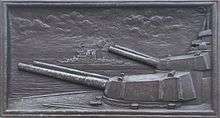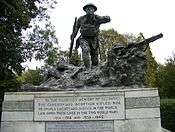Philip Lindsey Clark
| Philip Lindsey Clark | |
|---|---|
 | |
| Nationality | English |
| Education | Cheltenham School of Art, City and Guilds at Kennington, Royal Academy Schools |
| Known for | Sculpture |
| Notable work | Sculpture |
Philip Lindsey Clark (1889–1977) was an English sculptor.
Background
Philip Lindsey Clark was born in London. His father was the sculptor Robert Lindsey Clark.[1]
He worked with his father at the Cheltenham School of Art from 1905 to 1910 and then from 1910 to 1914 studied at the City and Guilds School in Kennington. He had a most distinguished war record in the First World War, winning the DSO. At the end of the war he returned to Royal Academy Schools to continue his training and remained there from 1919 to 1921. From 1920 to 1952 he was a regular exhibitor at the Royal Academy and from 1921 onwards at the Paris Salon. From 1930 his work became more and more of a religious nature and he became a Carmelite Tertiary. He eventually retired from London and lived in the West Country.[2][3]
Details of some of his works
| Place | Location | Notes and |
|---|---|---|
| Aylesford Priory | Aylesford | Clark carried out sculptural work for the Priory. Here he was assisted by his son Michael Clark.[4] |
| The Cameronians (Scottish Rifles) War Memorial | Kelvingrove Park, Glasgow, Scotland | The memorial commemorating The Cameronians (Scottish Rifles) is located in Kelvingrove, Glasgow and was unveiled on 9 August 1924 by Field Marshal The Earl Haig. It is located just outside Kelvingrove Art Gallery and Museum.[5] |
| English Martyrs' Church | Wallasey, Merseyside | Sculptures on the exterior of the church were by Clark.[6] |
| Holy Apostles Catholic Church | Pimlico, London | This church's Stations of the Cross are by Clark.[7] |
| Our Lady and St Edmund of Abingdon | Abingdon, Oxfordshire | Clark restored the statue of Our Lady for this church.[8] |
| Our Lady of Dolours Church | Hendon, Middlesex | Clark carved a white stone statue of Our Lady of Dolours for this church.[9] |
| Sacred Heart Church | Sheffield, Yorkshire | For Sacred Heart Church, Clark carved the Stations of the Cross, was responsible for the sculptural work on the font, created the statue of St Theresa and carried out the carvings in the tympanum above the entrance door.[10] |
| St Augustine's Church, Ramsgate | Ramsgate, Kent | Sculpture of St Anthony holding the child Jesus. Attached to central column inside the western wall. |
| St Bonaventure Church | Welwyn Garden City, Hertfordshire | Clark carved a statue of St Bonaventure which is located over the west door of the church.[11] |
| St Lawrence’s Church | Feltham, Middlesex | Clark carved several statues for this church.[12] |
| St Mary's Cemetery | Kensal Green, London | One of Clark's works was the "Belgian Soldiers' Memorial" in St Mary's Roman Catholic Cemetery in Kensal Green, Greater London. This was unveiled on 11 December 1932 by the Ambassador of Belgium.[13][14] |
| St Mary’s Church Glastonbury | Glastonbury, Wiltshire | Designed the statue "Our Lady St Mary of Glastonbury" for the Catholic Church on Magadalene Street, Glastonbury.[15] |
| St Mary's Church, Warrington | Warrington, Cheshire | Statue of "Our Lady of Lourdes" at St Mary's, Warrington.[16] |
| St Richard’s Roman Catholic Church | Chichester, Sussex | In 1963 Clark and his son Michael created a bronze crucifix for the front of this church.[17] |
| Shrewsbury Cathedral | Shrewsbury, Shropshire | Low-relief stone Stations of the Cross, 1952.[18] |
| Smethwick War Memorial | Smethwick, Warwickshire | War Memorial to the men of Smethwick killed in the First World War. Unveiled and dedicated in 1925.[19] |
| Southwark War Memorial | Southwark, Inner London | Southwark War Memorial was unveiled by General Lord Horn of Stirkoke on 16 November 1922 and dedicated on the same day by the Bishop of Southwark.[20] |
| Statue of William Dennis | Kirton, Lincolnshire | 1930 work features William Dennis known as the "Potato King".[21] |
| Westminster Cathedral | Westminster, London | In one of his most prestigious commissions, Clark carved the figure of St George in the Chapel of St George and the English Martyrs in Westminster Cathedral.[22] |
| Widegate Street | Spitalfields, City of London | Clark completed four sculptures representing bakers on the front of the premises of the 1926 built Nordheim Model Bakery building at numbers twelve and thirteen Widegate Street. This is a George Val Myers building.[23] |
Other work
Clark did other work in Sheffield apart from Sacred Heart church. One was a limestone motif and coat of arms above the main entrance to The Royal Institute of the Blind building in Mappin Street, executed in 1938. The building has been demolished, but the Clark sculpture has been kept and it was when a new Institute of the Blind building was built in Judd Street. The work was of a blindfolded head and the right hand column was topped by a hand interpreting Braille in front of a symbol for light. The work also featured the Royal coat of arms. It seems that Clark also worked on reliefs for the Gas Showrooms on Commercial Street in Sheffield.[24]
In 1960 at the St Theresa Of The Child Jesus Church in Manor, Sheffield, Clark carved the stone statue of St Theresa above the main door of the church and the low relief stone stations of the cross inside. He also designed the internal boss in relief at the centre the dome depicting the Assumption of the Blessed Virgin Mary into Heaven, visible from the sanctuary. He also carved the wooden statues of St Theresa kneeling, St Joseph the Carpenter, The Sacred Heart of Jesus and the Virgin Mary offering the swaddled Holy Child for the four side chapels. The wooden carvings were painted by his son Michael, who also carved and painted the larger than life size crucifix of Christ the King above the high altar.[25]
Gallery
 Southwark War Memorial- one of the bas-reliefs on the side of the memorial
Southwark War Memorial- one of the bas-reliefs on the side of the memorial Southwark War Memorial- Main sculpture- Advancing Infantryman
Southwark War Memorial- Main sculpture- Advancing Infantryman Belgian Soldiers’ Memorial in Kensal Green Cemetery- Pieta
Belgian Soldiers’ Memorial in Kensal Green Cemetery- Pieta View of The Caledonians (Scottish Rifles) Memorial. Image courtesy Eliott Simpson/Geograph.
View of The Caledonians (Scottish Rifles) Memorial. Image courtesy Eliott Simpson/Geograph.
References
- ↑ Philip Lindsey Clark. Mapping the Practice and Profession of Sculpture in Britain & Ireland 1851-1951. Retrieved 21 August 2012.
- ↑ Philip Lindsey Clark DSO, FRBS Mapping the Practice and Profession of Sculpture in Britain & Ireland 1851-1951.Retrieved 21 August 2012.
- ↑ Philip Lindsey Clark - Biography. Sculpture of Sussex. Retrieved 21 August 2012.
- ↑ History of the Friars. The Friars-Aylesford. Retrieved 21 August 2012.
- ↑ The Cameronians (Scottish Rifles) UKNIWM Ref: 2136. Retrieved 21 August 2012
- ↑ Historic England. "Roman Catholic Church of English Martyrs (1390589)". National Heritage List for England. Retrieved 27 September 2013.
- ↑ Stations of the Cross. Holy Apostles. Retrieved 21 August 2012. Note: Website with information on Clark and his work in the church
- ↑ Saint Edmund of Abingdon – Co-Patron with Our Lady of the Diocese of Portsmouth. Our Lady and St Edmund of Abingdon. Retrieved 21 August 2012.
- ↑ Parish History. Our Lady of Dolours. Retrieved 21 August 2012.
- ↑ Harman, Ruth and John Minnis. (2005). Sheffield: Pevsner City Guide. Yale University Press. p. 289. ISBN 0-300-10585-1.
- ↑ Statues, Memorials and Plaques in Welwyn Garden City & Hatfield. Lemsfordonline. Local and informative website which has a photograph of this work by Clark. Retrieved 21 August 2102.
- ↑ A Church Ablaze in Middlesex: St. Lawrence's, Feltham Catholic Archives. 8 October 1937. Retrieved 21 August 2012.
- ↑ Barres-Baker, M.C. "Our Belgian Guests" - Refugees in Brent, 1914-1919 Brent Council. Retrieved 20 August 2012
- ↑ Soldiers 1914-1918 UKNIWM Ref: 11889. Retrieved 21 August 2012.
- ↑ The Statue of Our Lady of Glastonbury. The Glastonbury Shrine. Retrieved 21 August 2012.
- ↑ Pollard, Richard and Nikolaus Pevsner. (2006). The Buildings of England. Lancashire: Liverpool and the South-West. New Haven and London: Yale University Press. pp. 608–610. ISBN 0-300-10910-5.
- ↑ St Richard’s Church in Chichester. Public Sculptures of Sussex. Retrieved 21 August 2012
- ↑ Historic England. "Roman Catholic Cathedral of Our Lady Help of Christians and St Peter (1270562)". National Heritage List for England. Retrieved 15 December 2013.
- ↑ Smethwick War Memorial. Ukniwm website gives description and details of any inscription. Retrieved 21 August 2012.
- ↑ Southwark War Memorial. UKNIWM Website. Reference 2120. Retrieved 21 August 2012
- ↑ Philip Lindsey Clark Glasgow - City of Sculpture. Retrieved 20 August 2012.
- ↑ Chapel of St George and the English Martyrs. Westminster Cathedral. Retrieved 21 August 2012.
- ↑ Pubs - Architectural Sculptures - London. Victorian Web. Retrieved 21 August 2012.
- ↑ Philip Lindsay-Clark motifs and coat of arms, 1938 Public Art Research Archive, Sheffield Hallam University. Retrieved 21 August 2012.
- ↑ Souvenir of the Solemn Opening of St. Theresa's New Church Sheffield. July,1960